Acute. Later, GP, geriatric
In December 1918 a public meeting was held at Ongar, during which it was decided to build a cottage hospital to commemorate those who had given their lives during the Great War and to celebrate the peace.
The Ongar and District War Memorial Hospital was officially opened on the August Bank Holiday 1932 by the Lord Lieutenant of Essex. Paid for by public subscription, private donations and fund-raising events, the red brick 2-storey building had 24 beds.
During WW2 the Hospital joined the Emergency Medical Service with 30 beds. Its operating theatre was enlarged to provide a new sterilising and scrub-up room, the costs of which were borne by the Ministry of Health. Various out-buildings also were erected, and an air-raid shelter adjacent to the ground floor ward.
After the war the Hospital was in financial difficulties, as were so many other voluntary hospitals due to a shortage of subscribers.
In 1948 it joined the NHS under the control of the Epping Group Hospital Management Committee, part of the North East Metropolitan Regional Hospital Board. It had 25 beds.
The Hospital provided medical care within a large rural area. Its rural location made it difficult to recruit staff, and consequently the number and type of cases admitted had to be restricted. General medical, surgical and maternity patients were accepted, but gradually the surgical work decreased until only emergency surgery and removal of tonsils and adenoids were performed (all other patients were referred to St Margaret's Hospital in Epping or to Chelmsford). The absence of a lift meant that stretcher patients had to be carried up a steep, winding stairway.
There was no Out-Patients Department (such patients were seen at St Margaret's Hospital), but a small Physiotherapy Department had been adapted from the air-raid shelter. The physiotherapist held treatment sessions several times a week, as well as attending to in-patients at St Margaret's Hospital.
The Regional Hospital Board proposed to enlarge the Hospital to create a laundry sorting room, a domestic staff dining room, a surgeon's dressing room and a storeroom, and to add a sitting room and extra WC to the Nurses' Bungalow, but financial restrictions postponed the plans. However, in 1950, washbasins were installed in the wards, as well as individual bedside call bells and wireless head sets. Two private patient rooms were available, each at the cost of £14 per week.
During 1951 the Hospital, along with the Waltham Abbey War Memorial Hospital, undertook to reduce the waiting list for tonsillectomy and adenoidectomy for the Group. All ear, nose and throat (ENT) surgery had been suspended during the epidemic of polio over the past two years.
In November 1952 the League of Friends, which had been founded in 1948, presented a TV set for the use of the patients.
From mid August 1953 the Hospital was closed for four weeks for redecoration.
In 1955 the Hospital had a maternity unit with 5 beds. Schoolchildren referred by the local school medical inspector attended the Physiotherapy Department in the old air-raid shelter. A new mobile X-ray unit had been purchased, and this was stored in the operating theatre, now rarely used.
In 1957 the Hospital Management Committee decided to dispose of the operating theatre equipment and to make the space available into a new Physiotherapy Department. Diathermy apparatus was purchased for the new Department. The entrance drive to the Hospital was covered with tarmac and a flower border added.
In 1964 the Hospital had 24 GP beds. In 1967 the weekly cost per in-patient was £35 10s 7d (£35.53). In 1969 bed occupancy was 74% (compared to about 65% in 1968).
In 1969 the Hospital was threatened with closure by the North East Metropolitan Regional Hospital Board. The maternity unit had closed and X-ray examinations were no longer performed. However, in 1970, in the face of fierce local opposition, the then Secretary of State for Health, Richard Crossman, agreed to spare it.
In 1974, following a major reorganisation of the NHS, the Hospital came under the control of the Essex Area Health Authority. It had 23 beds, of which 11 were occupied by GP cases. Five were used for respite care, 2 for terminal or palliative care, 1 was reserved for emergency psychiatric admissions, and the remaining 4 for patients transferred from other hospitals.
A single-storey Day Room was added at the back of the building in 1979 and a lift installed, both funded by the League of Friends.
By 1987, after another NHS reorganisation, the Hospital was under the control of the West Essex District Health Authority. A rear extension was built in 1988.In 1992 the Hospital had 22 beds and 14 places in the Day Hospital.In 1995 the southern end of the main ward was extended.
By 2001 it had 14 beds, as well as a Day Hospital, a clinic and a nurse-led admissions unit, which was aimed at reducing pressure on the beds in the local acute hospitals.
In 2003 the Hospital underwent a £500,000 refurbishment. It was re-opened by Lord Petre, Lord Lieutenant of Essex, who unveiled a commemorative plaque and dedicated the newly refurbished Hospital to the people of Ongar.
However, the West Essex Primary Care Trust, now in charge of the Hospital, decided that the Hospital's facilities were no longer suitable by modern standards. It argued that patients were accommodated in open wards (there was only one single room), making it difficult to maintain privacy and to manage nosocomial infections. The toilets were too small for disabled patients to use safely ... and that most of the patients anyway came from outside the Ongar area.
The Hospital closed in 2008, 90 years after the end of WW1, with the final Remembrance Day service being held in a special sunset ceremony. Services and in-patient facilities moved to St Margaret's Hospital.
Present status (September 2008)
The site is to be redeveloped by the West Essex Primary Care Trust. A £6.7m medical centre - to be named the Ongar War Memorial Medical Centre - is due to open in September 2011. It will contain two GP surgeries, a dentist and various clinics. The war memorial will be incorporated into the design.
The Roll of Honour inside the Hospital building has been preserved in the Essex Record Office.
Historical plaques and other artefacts from the Hospital are in the care of the Ongar Millenium History Society, which intends to put them on public display at various events in Ongar.
The painting of Budworth Hall Military Hospital painted in 1916 by George Rose, which used to hang in the entrance of the Hospital, was presented to the Ongar and District Community Association by NHS West Essex (previously known as West Essex Primary Care Trust).
Update: March 2011
The Hospital has been completely demolished. The projected opening of the new £7m health centre is now early in 2012.
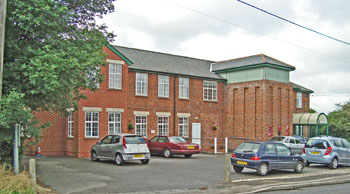
Ongar and District War Memorial Hospital.
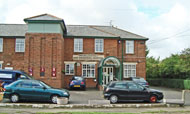
The main entrance and administrative building.
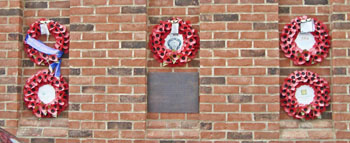
The War Memorial.
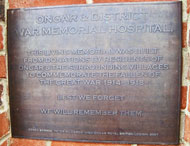
The plaque reads:
Ongar & District War Memorial Hospital.
This living memorial was built from donations by residents of Ongar & the surrounding villages to commemorate the fallen of the Great War 1914 - 1918
Lest we forget
We will remember them
Update: January 2011
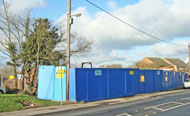
The Hospital has been completely demolished (above and below).
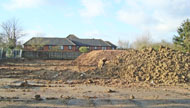
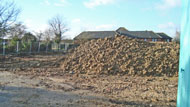
Update: March 2011
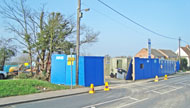
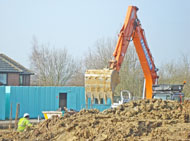
Work is now beginning on the new medical centre.
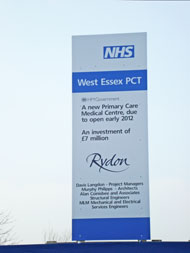
Signage for the new healthcare facilities.
http://archive.echo-news.co.uk
http://blakemorehistory.blogspot.com
http://hansard.millbanksystems.com (1969)
http://hansard.millbanksystems.com (1997)
http://uat.itrm.com
http://unlockingessex.essexcc.gov.uk
www.british-history.ac.uk
www.geograph.org.uk
www.guardian-series.co.uk (1)
www.guardian-series.co.uk (2)
www.thisistotalessex.co.uk (1)
www.thisistotalessex.co.uk (2)
www.thisistotalessex.co.uk (3)
www.westessexpct.nhs.uk (2008)
www.westessexpct.nhs.uk (2009a)
www.westessexpct.nhs.uk (2009b)
www.westessexpct.nhs.uk (2011)
Return to home page